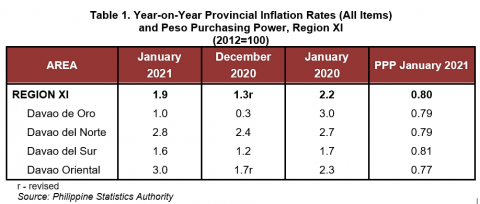Release Date :
Reference Number :
2021-004
 The Davao Region’s year-on-year regional inflation rose to 1.9 percent in January 2021. The current inflation was higher as compared to the previous month at 1.3 percent, however, it is relatively lower than the same month of the previous year at 2.2 percent. Further, the purchasing power of the peso (PPP) which measures the real value of the peso in a given period relative to a chosen reference period was at 80 centavos (see Table 1).
The Davao Region’s year-on-year regional inflation rose to 1.9 percent in January 2021. The current inflation was higher as compared to the previous month at 1.3 percent, however, it is relatively lower than the same month of the previous year at 2.2 percent. Further, the purchasing power of the peso (PPP) which measures the real value of the peso in a given period relative to a chosen reference period was at 80 centavos (see Table 1).The rising trend of inflation in January 2021 was partly affected by the higher annual increment in the index of Food and Non-Alcoholic Beverages from 0.3 percent in December 2020 to 1.5 percent in January 2021 (see Table 2). Other commodity groups that accelerated the inflation in January were the following:
• Restaurant and Miscellaneous Goods and Services, at 2.2 percent from 1.6 percent;
• Health, at 2.3 percent from 2.0 percent; and
• Housing, Water, Electricity, Gas, and Other Fuels, at 2.4 percent from 2.1 percent.
On the other hand, the transport index was reported to have slower annual increments at 2.3 percent from 3.2 percent. Meanwhile, the annual growth rate of the Education index, and Recreation and Culture index remained at 0.1 percent and -0.7 percent, respectively.

Inflation for selected food items particularly Meat was significantly higher at 11.5 percent from 6.4 percent in December 2020. Likewise, faster annual increases were reported in the indices of Vegetables and Fruits at 4.7 percent and 3.9 percent, individually. On the other hand, annual rates were lower in the indices of Sugar, Jam, Honey, Chocolate and Confectionery; and Food Products, N.E.C. at 0.9 percent, each (see Table 3).

Headline inflation in the Philippines continued to increase in January at 4.2 percent. Among the 17 administrative regions, Cagayan Valley had the highest inflation at 8.0 percent, while Zamboanga Peninsula had the lowest inflation at 0.2 percent (see Table 4).

Approved for release:
RUBEN D. ABARO, JR.
Director II
RSSO XI
